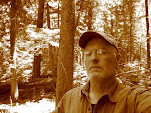I returned to the Scantic with M who seemed in need of a day in the canoe. Rather than explore the next section upriver, which would have the possibility of running into some impassable obstruction and short circuiting the adventure, I decided to repeat the same stretch that I did last week. Thunderstorms two days ago have added a good foot of water to the river, a fact that became obvious when we got to the first shallow patch a hundred yards from the start and we found that we had enough water for a full paddle stroke.
The current stayed steady and solid - a 2:1 flow with less pooling in the slow sections. The first big log, which I slid under before, now had to be dragged over. I cleared a couple rotten limbs and we slid the canoe over, the only trick being not to slip off the muddy bank.
 |
I told M that I would like to know what the USGS gauge height was for the river, and almost immediately I noticed and said, "there's a gauge." M hadn't seen one before. It was a tall concrete building - something like a cement phone booth. M looked for a gauge marker, but I explained that inisde the building would be a gas cylinder and some pressure instruments. The river height is measured by how much pressure is required to push a bubble of nitrogen out of a submerged tube. It was all hopeful until I got home and found out that this gauge stopped working thirty years ago.
Broad Brook was backed up enough that, out of curiosity we managed to get up a short ways. It became impassable soon enough. Turns out that there is a working USGS gauge somewhere nearby on Broad Brook. I do not know why the USGS went to the effort to put it there. Unfortunately, the gauge doesn't correlate with the Scantic water level.
Just past the Filter Beds we had to wade knee deep in fast current for about 50 or 75 yards. Fortunately, the bottom was good walking. The river returned to a wilder self as we continued, not that the current got faster, because it actually mellowed out some, but the surrounding forest became something deeper with the illusion of wilderness. At the next fast section we were unable to bust the current. The bottom was uneven - cobbles and small boulders and rather than wrestle with it - this was close to turn around time - we spun back.
The paddle out was swift. With frequent deadfalls to avoid, it was a good opportunity to teach M some new skills. We worked on back ferries, setting the canoe up ahead of time and letting the river do the work and getting a feel for how the current moves or grabs the canoe. It's all about efficiency - working when you need to work, drifting when you can. You can race down rivers like this at full speed, but you learn more by patiently picking your way through junk. It's good to have that in your back pocket for when you really need it.














